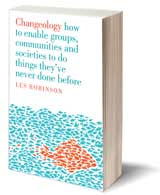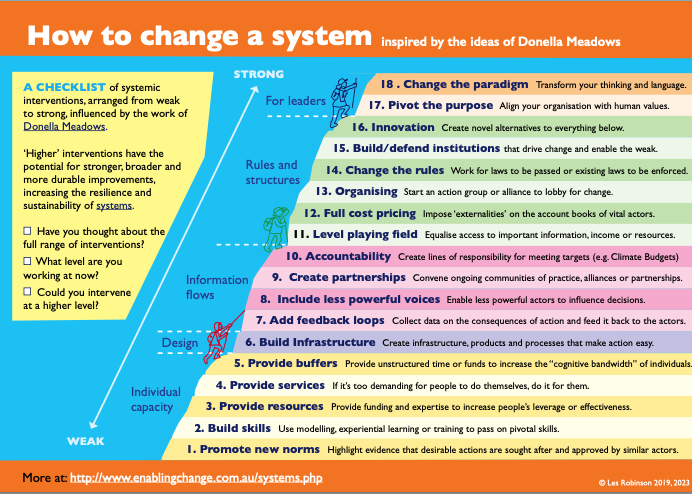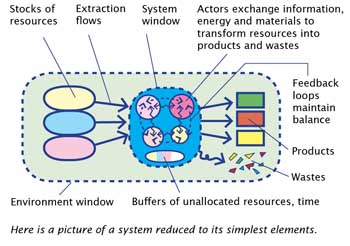|

|
How to change a system
The CEO of a Victorian catchment management authority shocked me when he admitted "Ten years ago we spent $400,000 ripping all the willows out of this river, now we're having to do it all again." Clearly that work had virtually no effect on the human-natural system of that catchment.
So often, watching teams design change projects, I see a very limited number of ideas in play. I see 'education' or 'awareness' all the time. OFTEN IT'S ALL I SEE. Really, there is so much more we can do.
Just how big is our palette of strategies? Really big.
I've struggled with this myself, gradually expanding the number of strategies. Finally, I got around to reading Donella Meadow's work, part of the tradition of systems thinking called System Dynamics (that also includes Peter Senge's well known The Fifth Discipline).
Donella, brilliantly, listed 12 'leverage points' to change a system, in increasing order of effectiveness, from weak to strong. She challenges us to move along the scale, choosing stronger interventions.
I've taken the liberty of adapting her system to suit the language that's more familiar to professionals in sustainability, public health, road safety and so on. Plus I've added a number of interventions that we're more familiar with.
In fact, I can see 18 leverage points. The weakest is 'facts'.
I hope this tool acts as a prompt to remind us just how big our palette of strategies really is, and to move from weak to strong.
This paper is just my opinion. This is an exciting, under-developed field and everyone's ideas are welcome.
Hope you like it.
First, what's a 'system'? Before reading on, it's a good idea to be clear what 'system' means in this context. Here are 28 short statements about systems.
Now to the main article: 18 ways to intervene in a system. The diagram below is a summary. Click here for full-sized PDF version.

What is a 'system'?A 'system', in this context, means any set of elements or actors that are more than the sum of their parts. Often the term 'complex adaptive system' is used, refering to systems that grow and evolve. 'Systems' include bodies, catchments, communities, economies, businesses, organisations, states. Really, the list is huge! It's hard to think of any entity that is not a system. Even arbitrary parts of systems work like systems. Also, 'system boundaries' are just conveniences - every system is more sprawling than we like to think. To create some clarity around the term 'system' here are 28 short statements about systems.
|

A useful tool: Situation diagnosis
This tool helps match the intervention style with the complexity and turbulence of the whole system that's the subject of the intervention.
Situation Diagnosis Tool.
What is system thinking practice?If 'systems thinking' is the idea, what would be our practice? The are many 'soft systems' practices and they all seem a bit similar: bring together the right people in facilitated workshops; avoid jumping to conclusions about the causes of the problem, or leaping to action; instead rethink the problem or need, expose assumptions, clarify purposes, get informed and inspired and develop a theory of change; only THEN start thinking about action. If you've done any of my workshops you'll be familiar with this approach (which we especially practice in Changeology).
Here is a short video that gives a nice snapshot of a soft systems process in action.
|
Some easy reading about systems thinkingHere is some good reading: Leverage points: Places to Intervene in a System by Donella Meadows System Failure by the Demos Foundation. |

